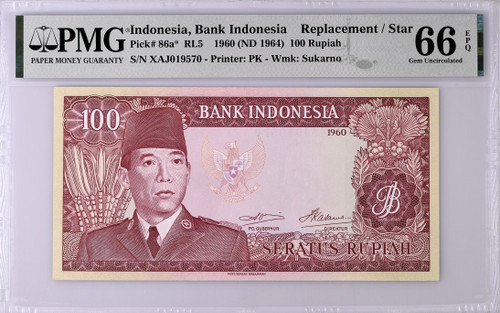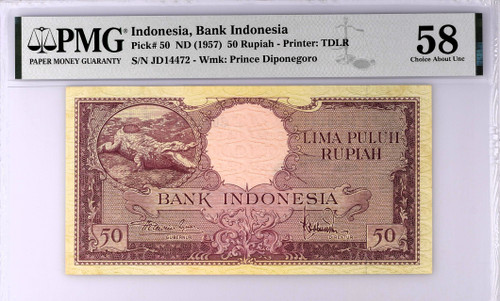1957 Indonesia 100 Rupiah P-51 PMG 66 EPQ Rare High-Grade Collectible
The 1957 Indonesia 100 Rupiah, cataloged as P-51 and graded PMG 66 EPQ (Exceptional Paper Quality), is a remarkable example of post-independence Indonesian currency. This high-grade banknote reflects the nation's rich cultural heritage and the vision for economic growth and stability, making it a highly desirable collectible.
Design and Features: This 100 Rupiah note is adorned with intricate designs that capture the essence of Indonesia's cultural identity and economic ambitions during the 1950s. The note likely features significant national symbols, historical figures, or landmarks that showcase Indonesia's journey towards progress and independence. The detailed engravings, vibrant colors, and advanced security features highlight the artistry and sophistication of Indonesian banknote design in this era. Graded PMG 66 EPQ, this note exemplifies superior quality, with sharp details, vivid colors, and exceptional paper quality.
Historical Significance: Issued in 1957, this banknote comes from a pivotal period in Indonesian history, as the country was establishing itself as an independent nation after centuries of colonial rule. The 100 Rupiah note embodies Indonesia's determination to build a stable economy and strong national identity. It reflects the broader socio-economic changes and challenges faced by the country during the mid-20th century.
Collector's Value: The PMG 66 EPQ grade attests to the pristine condition and high quality of this banknote, making it a valuable piece for collectors interested in Southeast Asian currencies, historical banknotes, or Indonesian economic history. Its rarity, historical context, and design excellence make it a prized addition to any collection focused on world currencies or post-colonial economic development.
















